
Amebiasis
By
Dr. Ameer kadhim Hussein.
M.B.Ch.B. FICMS (Community
Medicine).

IDENTIFICATION
The term "amoebiasis" has been defined by WHO as the condition
of harbouring the protozoan parasite Entamoeba histolytica with or
without clinical manifestations.
The symptomatic disease occurs in less than 10 percent of infected
individuals. The symptomatic group has been further subdivided
into intestinal and extraintestinal amoebiasis. Only a small
percentage of those having intestinal infection will develop invasive
amoebiasis.

IDENTIFICATION
The intestinal disease varies from mild abdominal discomfort and
diarrhoea to acute fulminating dysentery.
Extraintestinal amoebiasis includes involvement of liver (liver
abscess), lungs, brain, spleen, skin, etc.
Amoebiasis is a potentially lethal disease. It carries substantial
morbidity and mortality.

IDENTIFICATION
Infection with Entamoeba histolytica is a leading
parasitic cause of death in developing nations and
is an important health risk to travelers.
Amebiasis is transmitted by parasite cysts via fecal-
oral contamination from infected individuals or
from contaminated food or water.
E. histolytica infections may be noninvasive and
asymptomatic or may cause varying degrees of
symptoms through tissue invasion.
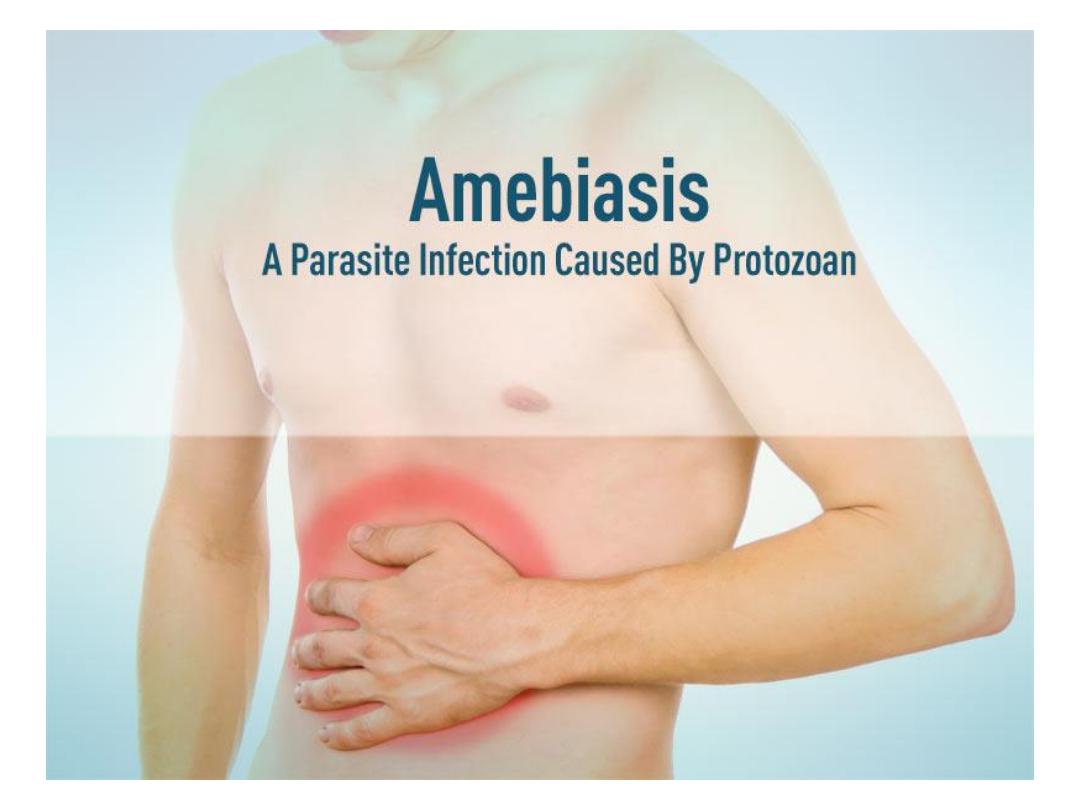

INFECTIOUS AGENT
Amoebiasis is caused by potentially pathogenic strains of E.
histolytica.
E. histolytica exists in two forms vegetative (trophozoite) and cystic
forms. Trophozoites dwell in the colon where they multiply and
encyst. The cysts are excreted in stool. Ingested cysts release
trophozoites which colonize the large intestine. Some trophozoites
invade the bowel and cause ulceration, mainly in the caecum and
ascending colon; then in the rectum and sigmoid. Some may enter a
vein and reach the liver and other organs.

INFECTIOUS AGENT
The trophozoites are short-lived outside the human body;
they are not important in the transmission of the disease.
In contrast the cysts are infective to man and remain viable
and infective for several days in faeces, water, sewage and
soil in the presence of moisture and low temperature. The
cysts are not affected by chlorine in the amounts normally
used in water purification, but they are readily killed if
dried, heated (to about 55 deg C) or frozen.
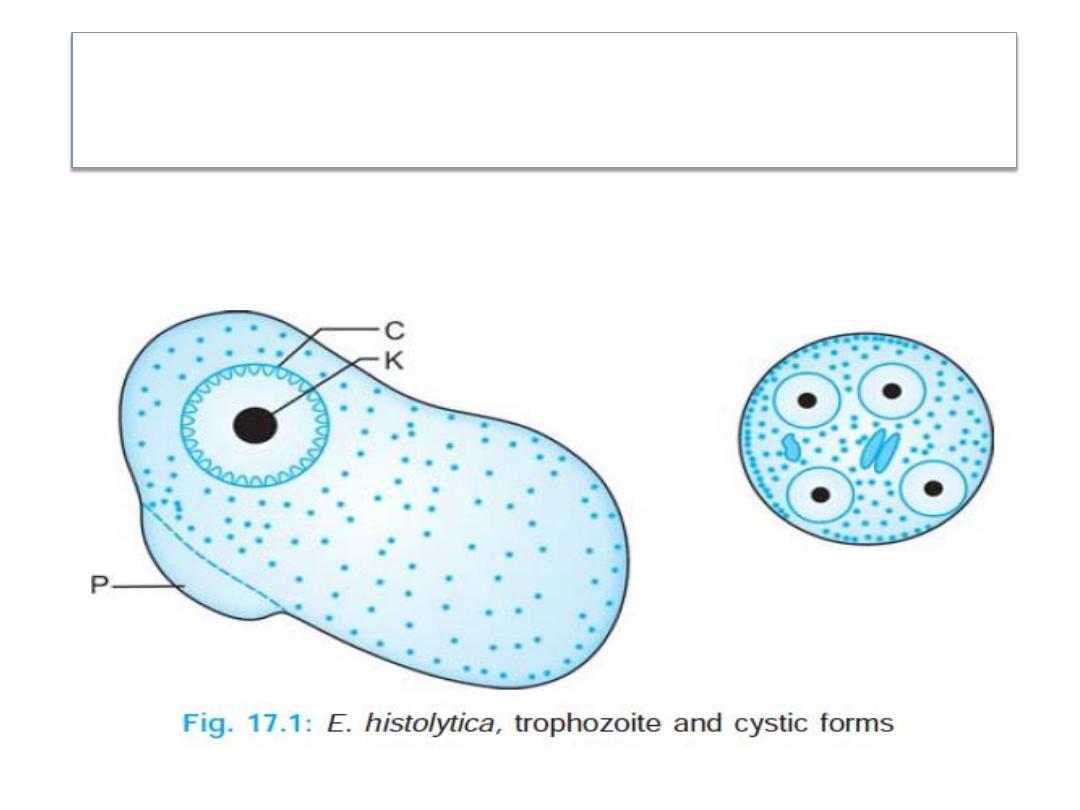
INFECTIOUS AGENT

RESERVOIR
Man is the only reservoir of infection. The
immediate source of infection is the faces
containing the cysts.
Most individuals infected with E. histolytica
remain symptom free and are healthy
carriers of the parasite.
The greatest risk is associated with carriers
engaged in the preparation and handling of
food.

PERIOD OF COMMUNICABILITY
As long as cysts are excreted; the period
may be several years, if cases are
unrecognized and untreated.
INCUBATION PERIOD
Variable from few days to several months or
years, commonly 2 to 4 weeks or longer

MODES OF TRANSMISSION
Water polluted with sewage may cause an
epidemic, the feco oral route being the
predominant mode of entry. Food handlers,
if they are convalescent or healthy carriers,
play an important role.
Flies and cockroaches can harbour cysts and
contaminate food. Farm vegetables
contaminated by sewage may infect man.

MODES OF TRANSMISSION
Sexual transmission as a result of oro anal
contact, especially among male
homosexuals, has been increasingly
reported during recent years.
Poverty, ignorance and poor sanitation are
favorable to the spread of disease in
developing countries. Hot, dry climate is
inimical to the cysts.
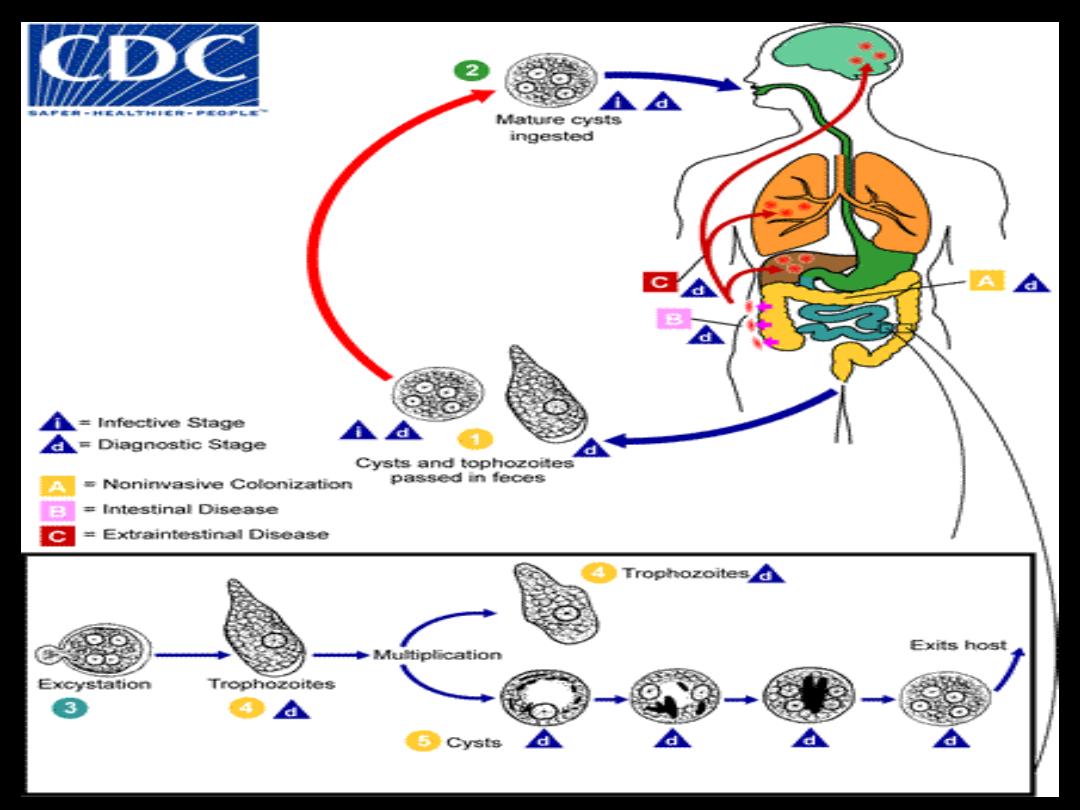
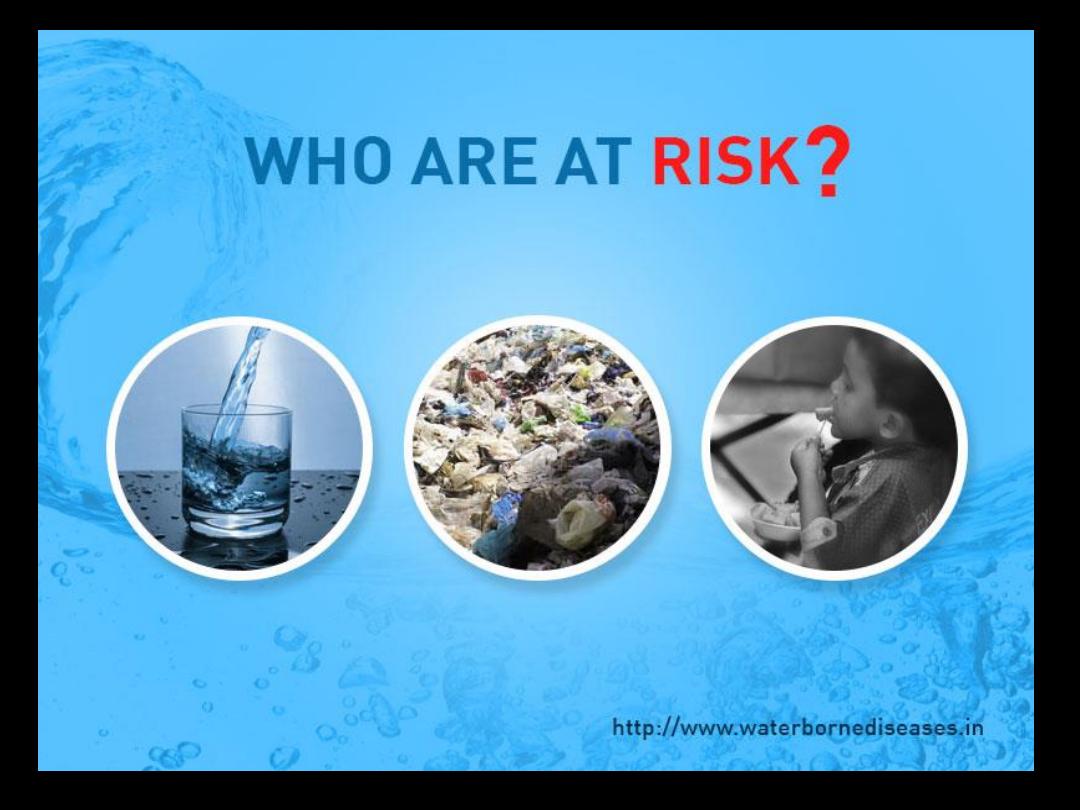

HOST FACTORS
Amoebiasis may occur at any age. There is no sex or
racial difference in the occurrence of the disease.
Amoebiasis is frequently a household infection.
When an individual in a family is infected, others in
the family may also be affected. Specific anti-
amoebic antibodies are produced when tissue
invasion takes place. There is strong evidence that
cell mediated immunity plays an important part in
controlling the recurrence of invasive amoebiasis.

ENVIRONMENTAL FACTORS
Amoebiasis is more closely related to poor sanitation
and socio-economic status than to climate.
In countries with marked wet-dry seasons, infection
rates are higher during rains, presumably since cysts
may survive longer and the potential for transmission
is there by increased. Epidemic outbreaks are usually
associated with sewage seepage into the water supply.

EPIDEMIOLOGY
Amoebiasis is a common infection of the human gastro-
intestinal tract. It has a worldwide distribution. It is a major
health problem in the whole of China, South East and West
Asia and Latin America, especially Mexico.
Globally it is estimated that 500 million people carry E.
histolytica in their intestinal tract and approximately one-tenth
of infected people suffer from invasive amoebiasis. It is
probable that invasive amoebiasis, accounted for about
100,000 deaths in the world.

EPIDEMIOLOGY
Prevalence rates vary from as low as 2 per cent to 60 per cent
or more in areas devoid of sanitation. In areas of high
prevalence, amoebiasis occurs in endemic forms as a result of
high levels of transmission and constant reinfection.
Epidemic water-borne infections can occur if there is heavy
contamination of drinking water supply.

EPIDEMIOLOGY
Amebiasis has a worldwide distribution but is most common in the
developing world.
In underdeveloped areas where drinking water is obtained from fecally
contaminated water sources and contaminated water or sewage is used
to grow or freshen vegetables, amebiasis has high incidence.

Clinical features
There is a variable clinical response to E. histolytica infection. Invasive
amebiasis leading to dysentery, liver abscess, pleuro-pulmonary
involvement, or, less commonly, involvement of other organs occurs in
the minority of infections. The majority of cases have either non-
dysenteric intestinal amebiasis with mild to moderate symptoms or are
asymptomatic cyst passers.
Amebic dysentery, or acute amebic colitis, usually has an incubation of
about 8 to 10 days, and onset is often sudden. Typical acute symptoms
include severe abdominal cramps, chills, fever, nausea, headache, and
tenesmus. The stools are liquid and contain bloody mucus with
leukocytosis. In very severe cases, The complications can be fatal.
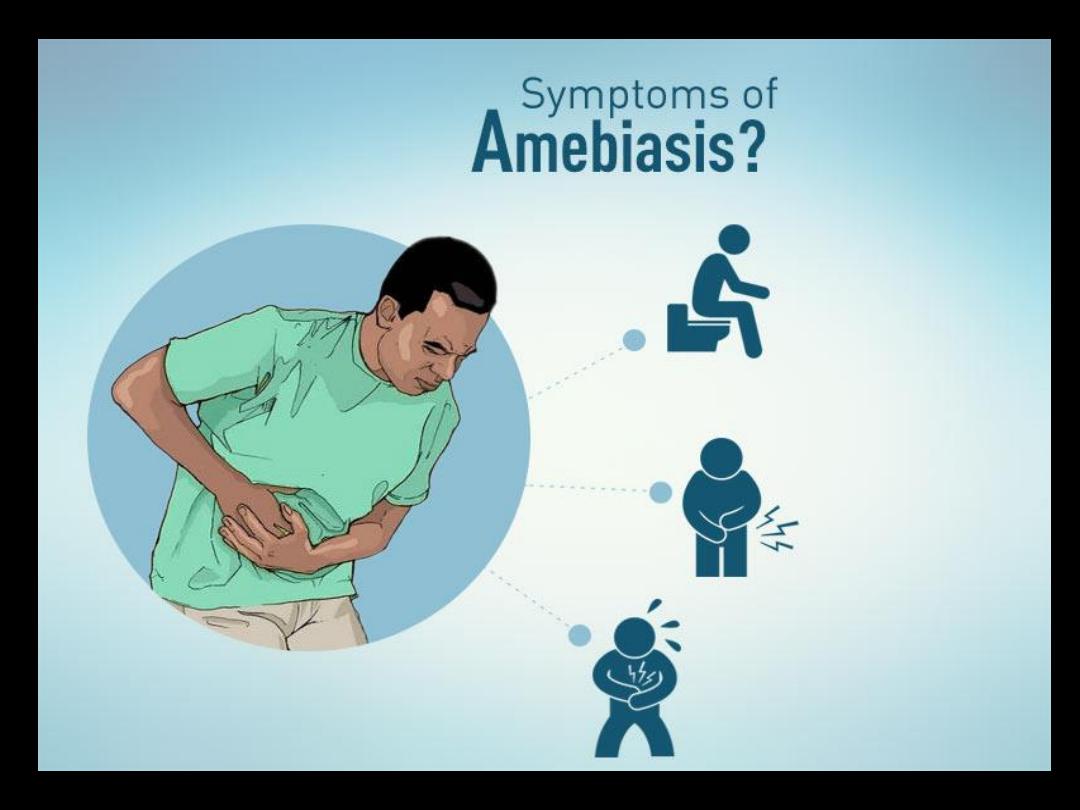
Extra-Intestinal Amebiasis
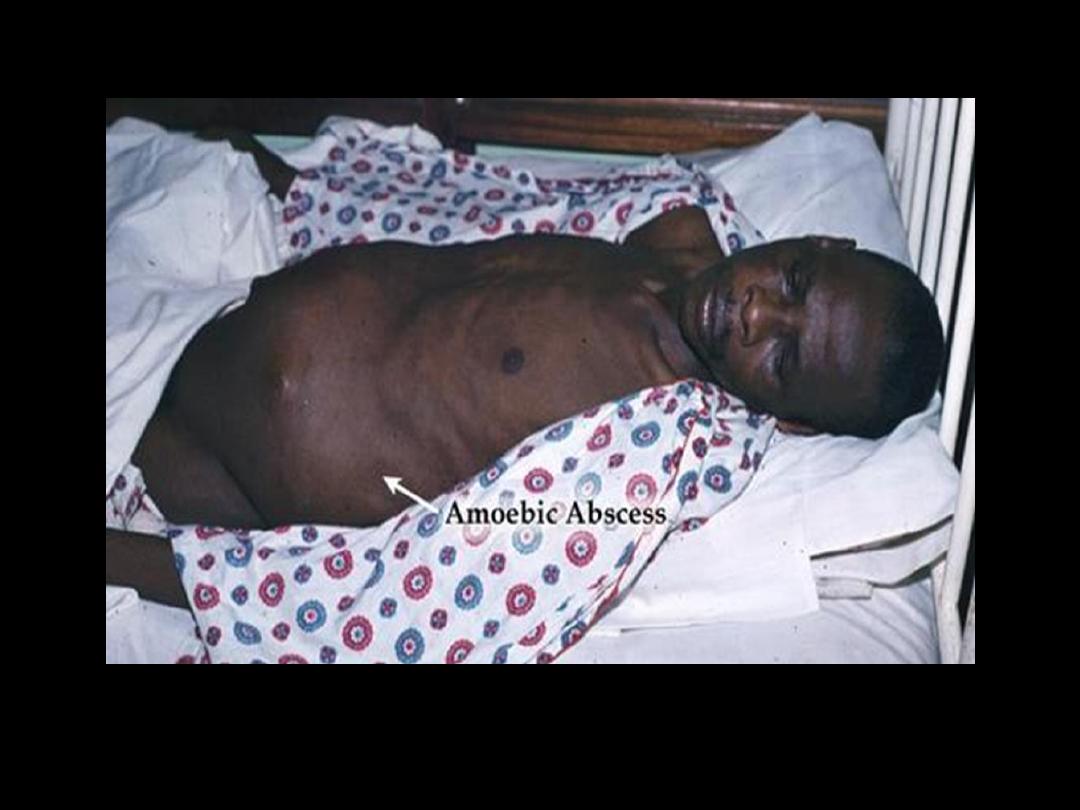


Primary prevention
a. Sanitation : Safe disposal of human excreta coupled with
the elementary sanitary practice of washing hands after
defecation and before eating is a crucial factor in the
prevention and control of amoebiasis.
But there are too many hurdles (both social and economic) in
enforcing it in many developing countries. With the
cooperation of the local community, the sanitary systems
should be constructed taking into consideration the customs
and practices of the population and the available resources.

Primary prevention
b. Water supply : The protection of water supplies
against faecal contamination is very important because
amoebic cysts may survive for several days and weeks
in water. The cysts are not killed by chlorine in
amounts used for water disinfection. Sand filters are
quite effective in removing amoebic cysts. Therefore
water filtration and boiling are more effective than
chemical treatment of water against amoebiasis.

Primary prevention
c. Food hygiene:
Environmental measures should also include the protection
of food and drink against faecal contamination. Uncooked
vegetables and fruits should be disinfected.
In most instances, thorough washing with detergents in
running water will remove amoebic cysts from fruits and
vegetables.
Since food handlers are major transmitters of amoebiasis,
they should be periodically examined, treated and educated
in food hygiene practices such as hand washing.
d. Health education of the community about the risk of
disease and mode of transmission and preventive
measures.

Secondary prevention
Diagnosis and treatment:
Diagnosis By microscopic demonstration of trophozoites or cysts in
fresh stool specimens, smear of aspirates obtain by proctoscopy or
aspirates of abscess or sections of tissue.
Demonstration of trophozoites containing red cells is diagnostic. They
are most readily seen in fresh mucus passed per rectum.
Serological tests are often negative in intestinal amoebiasis, but if
positive, they provide a clue to extraintestinal amoebiasis.
Indirect haemagglutination test (IHA) is regarded as the most sensitive
serological test. Newer techniques include counter immuno-
electrophoresis (CIE) and ELISA techniques.

Secondary prevention
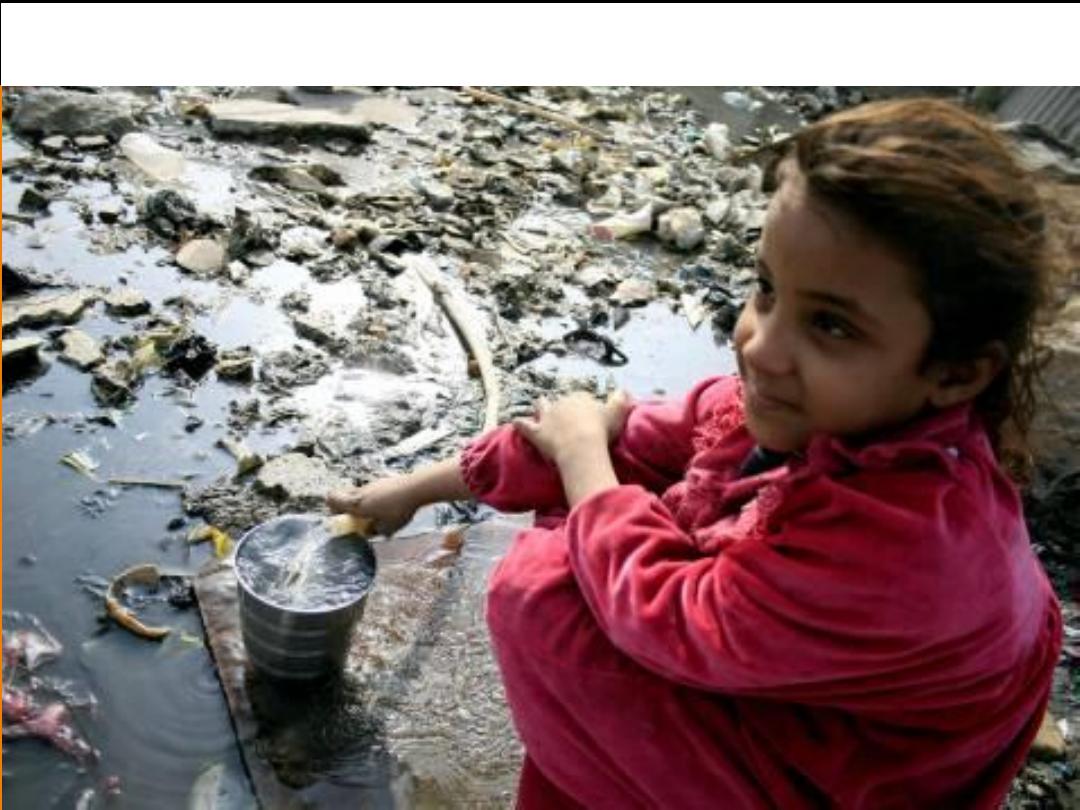
Avoid un safe source of water supply
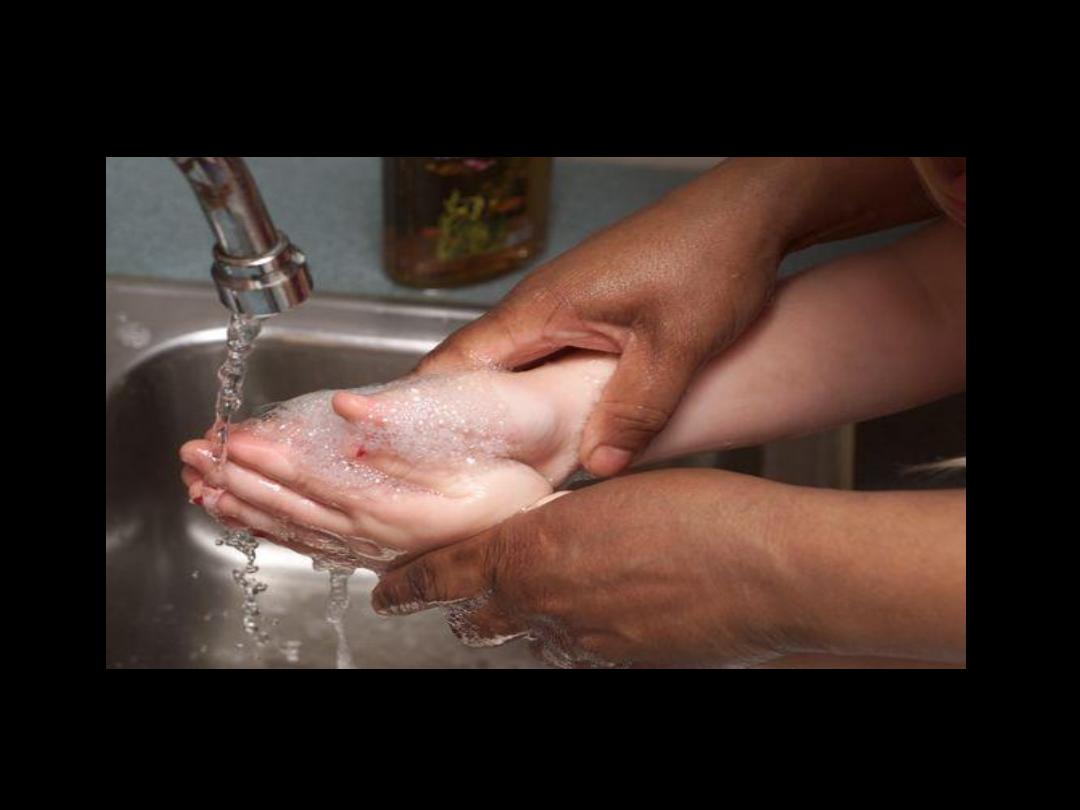
Thank you for wash your hand
